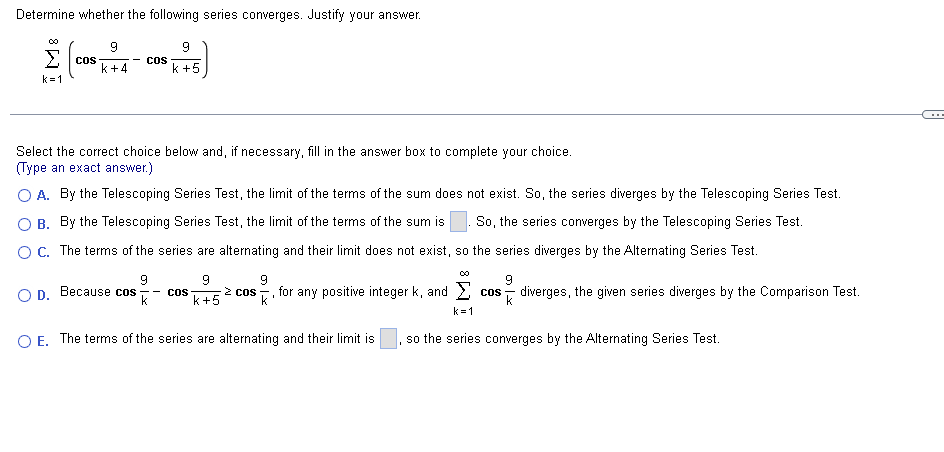Determine whether the following series converges. Justify your answer. 9 Σ (COST-COS 15) k+4 k+5 k=1 Select the correct choice below and, if necessary, fill in the answer box to complete your choice. (Type an exact answer.) O A. By the Telescoping Series Test, the limit of the terms of the sum does not exist. So, the series diverges by the Telescoping Series Test. OB. By the Telescoping Series Test, the limit of the terms of the sum is So, the series converges by the Telescoping Series Test. OC. The terms of the series are alternating and their limit does not exist, so the series diverges by the Alternating Series Test. 9 9 9 18
Determine whether the following series converges. Justify your answer. 9 Σ (COST-COS 15) k+4 k+5 k=1 Select the correct choice below and, if necessary, fill in the answer box to complete your choice. (Type an exact answer.) O A. By the Telescoping Series Test, the limit of the terms of the sum does not exist. So, the series diverges by the Telescoping Series Test. OB. By the Telescoping Series Test, the limit of the terms of the sum is So, the series converges by the Telescoping Series Test. OC. The terms of the series are alternating and their limit does not exist, so the series diverges by the Alternating Series Test. 9 9 9 18
Advanced Engineering Mathematics
10th Edition
ISBN:9780470458365
Author:Erwin Kreyszig
Publisher:Erwin Kreyszig
Chapter2: Second-order Linear Odes
Section: Chapter Questions
Problem 1RQ
Related questions
Question

Transcribed Image Text:Determine whether the following series converges. Justify your answer.
9
Σ (CO-CO₂)
Σcos-
k+4
k +5
k=1
Select the correct choice below and, if necessary, fill in the answer box to complete your choice.
(Type an exact answer.)
O A. By the Telescoping Series Test, the limit of the terms of the sum does not exist. So, the series diverges by the Telescoping Series Test.
B. By the Telescoping Series Test, the limit of the terms of the sum is. So, the series converges by the Telescoping Series Test.
O C. The terms of the series are alternating and their limit does not exist, so the series diverges by the Alternating Series Test.
O D. Because cos
9
9
9
cos- > cos
k+5
9
k
00
for any positive integer k, and cos diverges, the given series diverges by the Comparison Test.
k
k=1
O E. The terms of the series are alternating and their limit is so the series converges by the Alternating Series Test.
Expert Solution
This question has been solved!
Explore an expertly crafted, step-by-step solution for a thorough understanding of key concepts.
Step by step
Solved in 3 steps

Recommended textbooks for you

Advanced Engineering Mathematics
Advanced Math
ISBN:
9780470458365
Author:
Erwin Kreyszig
Publisher:
Wiley, John & Sons, Incorporated

Numerical Methods for Engineers
Advanced Math
ISBN:
9780073397924
Author:
Steven C. Chapra Dr., Raymond P. Canale
Publisher:
McGraw-Hill Education

Introductory Mathematics for Engineering Applicat…
Advanced Math
ISBN:
9781118141809
Author:
Nathan Klingbeil
Publisher:
WILEY

Advanced Engineering Mathematics
Advanced Math
ISBN:
9780470458365
Author:
Erwin Kreyszig
Publisher:
Wiley, John & Sons, Incorporated

Numerical Methods for Engineers
Advanced Math
ISBN:
9780073397924
Author:
Steven C. Chapra Dr., Raymond P. Canale
Publisher:
McGraw-Hill Education

Introductory Mathematics for Engineering Applicat…
Advanced Math
ISBN:
9781118141809
Author:
Nathan Klingbeil
Publisher:
WILEY

Mathematics For Machine Technology
Advanced Math
ISBN:
9781337798310
Author:
Peterson, John.
Publisher:
Cengage Learning,

